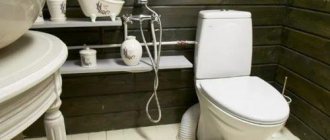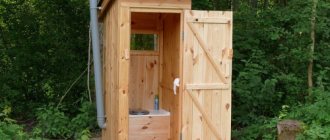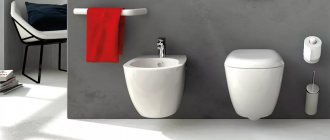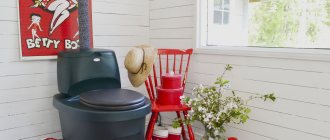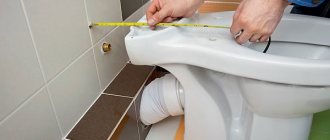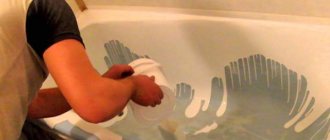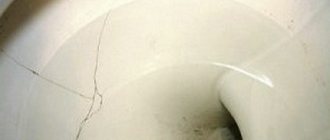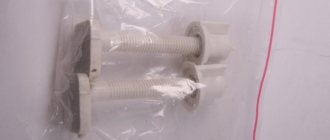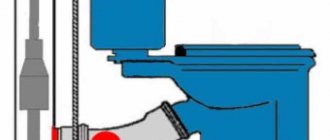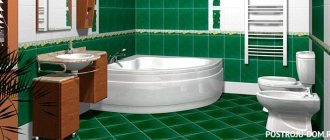Choosing a location for installing a bathroom
Layout of the toilet on the site
When arranging a cesspool for draining waste from a toilet in a country house, you must adhere to the requirements of regulatory documents, which provide for:
- the distance to the source of drinking water should be at least 20 m, and in the presence of sandy and other loose soils it increases to 50 m;
- the distance from residential buildings should be 10-12 m;
- there should be a distance of 1-2 m to the fence on the site;
- It is recommended to plant fruit trees no closer than 4 m apart;
- the distance to the road is at least 5 m.
In this case, it is necessary to take into account not only the structures that are located on a specific summer cottage, but also neighboring buildings.
Which option should I choose?
What should you consider when choosing one option over another? The following factors should be considered:
Waste volume
Try to figure out how often you will use the toilet? How many people will use the restroom? The volume of waste and, accordingly, the method of its disposal greatly depend on this. This is perhaps the main factor influencing the choice of toilet.
Depth of groundwater
If the groundwater level is high, pit toilets and, in some cases, septic tanks are excluded.
Check the groundwater level in the spring.
Finance
How much money are you willing to spend on arranging a toilet? There are options from the cheapest to super expensive septic tanks. It all depends on your wallet and wishes.
Recycling
Any toilets require waste disposal sooner or later. Think about all this in advance when choosing one or another toilet option. You must understand how to clean your toilet, how difficult and expensive it is.
Cesspool for a bathroom
If you install a flush on an outdoor toilet for a summer residence, you need to more carefully select and arrange the cesspool. Its volume should be such as not to pump out the accumulated liquid too often. On average, a cesspool with a filtration bottom and walls is enough for a dacha where 2-4 people live. In this case, there is no need to pump out waste frequently. To set it up, you need to do the following:
Cesspool diagram
- You need to dig a hole 2-2.5 m deep and 1x1 m in size.
- Place a layer of crushed stone 15 cm thick at the bottom of the pit. Compact it thoroughly.
- Fill in a layer of sand 15 cm thick.
- Lay the walls using red brick or rubble stone. You can use old material that remains after dismantling unnecessary buildings. To connect the elements, use a regular cement-sand mortar. Leave a gap of 1-2 cm between the bricks to filter liquid from the toilet in the country.
- As an alternative, you can use a large plastic container in which you need to cut out the bottom and make holes in its walls.
- The cesspool should rise 15 cm above the ground surface to prevent water from entering from the site.
- Fill the space between the walls and the soil with crushed stone to 2/3 of the height. Closer to the surface, use sand, which must be compacted thoroughly.
- Cover the cesspool with a concrete slab lid and provide a hole for connecting sewer pipes to drain waste.
When using a completely sealed cesspool for a dacha bathroom where there is a drain, you need to use reinforced concrete rings or a structure made of monolithic concrete or brick with waterproofing. In this case, you need to pump out the accumulated liquid several times a year, but you don’t have to worry about groundwater contamination.
This is especially true for areas where they are located at a shallow depth - 2.5 m or higher.
Building a toilet
Features of a toilet for a summer residence with a toilet
Organizing a toilet with a comfortable toilet will significantly increase the level of comfort at the dacha.
The main feature of the toilet for the dacha is that it is most often a separate building, less often it is equipped in the house.
But this does not mean that it should not be comfortable and convenient. There are many options for arranging a rustic toilet with a toilet. There are the simplest options in the form of a cesspool without any cleaning. And there are modern models with high-quality waste treatment. In this case, all environmental protection conditions are observed.
Organization of the sewer system
From the toilet in the country, which has a flush, you need to organize a sewer system. This can be made from pipes with a diameter of 50-100 mm. It is best to use PVC elements that do not rot, are durable, easy to install and inexpensive. Also, such a system can be easily repaired if necessary. Install them at a slight slope of about 20%. To prevent sewer pipes from freezing in winter, insulate them with any material with low thermal conductivity.
Simple drainage sewer system for a summer residence
If there is a large volume of wastewater, it is necessary to equip a septic tank with several containers. You can also additionally use preparations with special microorganisms that break down biological material. As a result, solid particles settle at the bottom of the first tank, and the liquid component moves to another container, which I make without a bottom. In this case, clean water is absorbed into the soil, which does not pollute the environment.
Sewerage laying
Choosing an area for construction
Of course, everyone has the right to decide for themselves where to start construction of such a specific facility, but there are a number of sanitary and hygienic standards and restrictions that must be taken into account when choosing the location of the toilet:
- Strict rules regulate the minimum allowable distance between a country toilet and a well, the water from which is used for domestic needs. The construction site must be at least 25 m away from water intake sources;
Note! When choosing a site, you should take into account not only your own interests and the location of your well, but also take into account the interests of your neighbors and take into account the location of wells on their sites.
- Naturally, the arrangement of such a room is not carried out in the center of the site. Try to choose a more modest, remote location for such construction. It is also prohibited to place a toilet on the very border of the site; you must step back at least 1 meter from it;
- If the area is uneven and there is some elevation difference, then the toilet should be located in a low area;
- Also take into account the wind rose in order to prevent the spread of unpleasant odors throughout the area;
- For ease of use, consider in advance the convenience of driving the sewer truck directly to the cesspool in order to clean it, because this will still have to be done periodically.
Stages of construction of an outdoor bathroom
It is possible to build a toilet in the country that has a flush if you adhere to the following work technology:
Diagram of the ventilation system for the toilet
- You need to make a reliable foundation for the toilet booth. To do this, dig 4 holes in the corners of the future structure with a depth of 0.8-1 m and a diameter of 20 cm.
- Using a pipe or wooden boards, make a formwork that should rise 20 cm above the ground level.
- Fill the holes with small crushed stone to the full height and fill them with cement-sand mortar.
- Insert metal pins, which should sink into the concrete to a depth of 8-10 cm, leaving 10 cm on top.
- Using wooden blocks with a cross-section of 10x10 cm, make the bottom frame for the frame. Secure all elements using foundation studs and be sure to additionally secure with nuts.
- In the corners of the structure, install wooden posts made of timber of the same section. Secure them with metal corners and small spacers made from boards.
Outdoor toilet - Check the vertical installation of the frame, and then fasten it with horizontal jumpers from the same timber.
- Build a shed or gable roof using sheathing and rafters made from wood planks or beams. Use bitumen shingles, roofing felt or slate sheets as roofing material.
- In the place where the door is attached, install additional racks - 2 vertical and 1 lintel.
- The country bathroom should be covered with wooden clapboard or simple sanded boards. At the same time, leave a small window to illuminate the interior of the toilet during the daytime. Don't forget to glaze it.
- Install the finished door on the hinges or build it yourself from the material that was used to line the walls.
DIY toilet
The procedure for constructing a toilet for a country toilet with your own hands is average in terms of labor intensity; it can be performed even by a master who does not have much experience in construction. An outdoor toilet can be made from various materials.
Watch the video
Wooden step
The most popular choice is to install a wooden step. Before starting the procedure, you should study the construction diagram in order to calculate the suitable dimensions of a country street toilet.
Algorithm for constructing a wooden structure of this type:
- Cover approximately half of the floor with boards.
- At a distance of 35-45 cm from the floor surface, install a transverse beam in the middle; it will become the basis of the frame.
- The vertical part of the step is built up to the cross beam.
- The upper part of the structure is laid.
- In the top boards it is necessary to cut a hole corresponding in size to the diameter of the plastic seat.
- If necessary, the structure is coated with varnish or paint.
- The seat is installed on top and secured with screws or nails.
If you plan to build a wooden country toilet with a toilet on the street, then at the design stage it is important to provide a ventilation system.
Because Sewerage in most cases has an unpleasant odor; it is recommended to build a ventilation pipe approximately 3 meters long. This will significantly increase the comfort of visiting the bathroom.
Galvanized toilet
The main advantages of an outdoor toilet of this type are ease of installation and availability of materials. By design, the model is a cylinder with allowances on both sides.
Due to the low price of consumables, this option is in most cases chosen by owners of sites that are rarely visited.
Installation instructions:
- Find the optimal pipe size. Its height should be more than 40 cm, and its diameter should be about 33 cm.
- Make small cuts at the seam allowances (5 cm intervals), then bend the ends to give it a daisy-like shape.
- Fix the lower bent ends to the floor with self-tapping screws, and the upper ends to the plywood sheet (with a width greater than 8 cm).
- Adjust the base for the toilet seat and secure it on top.
- Place the created structure over the drainage pit.
To improve the appearance around the outdoor toilet, the frame is covered with plywood sheets or boards. In general, this design does not have a very attractive appearance, but the materials for manufacturing are quite easy to find, and installation takes a minimum of time.
Toilet made from a chair
The simplest solution is to make a toilet seat from an old chair. A similar toilet without a water seal for an outdoor country toilet is built quite quickly and requires additionally only plywood sheets and, in some cases, plastic.
It is important that the chair is durable and its elements are securely fastened. Otherwise, the chair will break quite quickly and the construction procedure will have to be repeated.
Construction algorithm:
- Instead of a standard seat, you will need to place a sheet of plywood.
- A small hole is made so that a jigsaw can fit through it. Then, using a jigsaw, a hole is cut to the size of the plastic toilet seat.
- A toilet seat is placed on the hole, then it is securely fixed.
- You can line the chair with plastic around the perimeter of the legs to improve appearance or increase stability.
- The chair is placed above the drain hole.
For greater reliability, the chair legs are additionally fixed. This is the cheapest and easiest way to build an outdoor country plumbing fixture with your own hands.
However, it is important to note that such a solution most likely cannot be used on an ongoing basis if you use the bathroom all year round.
The design is best suited as a temporary solution or when visiting a dacha not all year round.
Interior design of an outdoor bathroom
After installing the toilet booth, proceed to its internal arrangement:
Comfortable toilet inside
- Lay sewer pipes to the septic tank, which will then need to be connected to the toilet to drain the waste.
- Pour the cement screed to a height of 15-20 cm. Strengthen it with a metal mesh.
- Install the toilet. As a tank, use a small plastic barrel with a volume of 50 liters, which is installed under the ceiling. To drain, you just need to open the ball valve using the handle. In this case, there will be enough water for 15-25 flushes, which will be enough for a day for a family of 3-4 people.
- Provide electricity inside the outdoor bathroom. Install a luminaire with a 40 W lamp.
- Inside the outdoor bathroom, you can additionally install a small washbasin, which is also connected to this cesspool and a tank for water supply.
- Using 4 boards, put together a box, which you install on the back wall of the bathroom. It should come out through a hole in the roof. In this way, you can arrange ventilation and there will be no unpleasant odor in the room.
- Paint all surfaces inside and outside the structure with paint or apply moisture-resistant varnish.
A more economical option involves installing a cesspool directly under the toilet. In this case, the water drains through a hole in the cesspool cover.
Draining a toilet in a summer cottage is a convenient and effective solution. To do this, you do not need to use complex design schemes or expensive materials.
Plot
4 votes
+
Vote for!
—
Vote against!
Even if the dacha is just a bare piece of land without a single building, you still cannot do without the main thing - a toilet. The need for this simple construction arises after just a few hours of being at the dacha. Despite the fact that we all imagine what a toilet should look like and what needs to be done, there is still no need to rush. First of all, you should study the site to understand what type of country toilet can be built in a particular case, because there are several of them. Then you need to decide where exactly you can put the toilet, while observing sanitary rules and regulations. And only after this can you begin construction itself. There is nothing difficult about making a country toilet with your own hands. However, you don't have to make the toilet box yourself. The modern market can offer ready-made toilet houses for every taste. In this article we will look at instructions on how to make a toilet with your own hands, starting with choosing the type of toilet and ending with making a house.
- What kind of toilet can be equipped in a country house - types and features
- Where can you place a country toilet - rules and recommendations
- Do-it-yourself toilet in the country - instructions for building a powder closet
- Country toilet drawing
- Foundation and support for toilet
- We make the frame of an outdoor toilet
- We cover the toilet body and make a roof
- Hanging the door
- Setting up a toilet seat
- How to build a toilet in a country house with a cesspool
- Country toilet backlash-closet and its features
What kind of toilet can be equipped in a country house - types and features
In a well-equipped dacha, where there is a house and you can actually live, it is advisable to have two toilets - one in the house and the second on the street. It is convenient to use a toilet in the house at night or in bad weather when it rains. Still, the house is warmer and more comfortable. An outdoor toilet for a dacha is necessary in order to use it during the day after gardening work on the site and not carry dirt from the street into the house.
There are several types of toilets that can be used in the country:
- Outdoor toilet with pit cesspool.
- Powder closet.
- Backlash closet.
- Dry toilet.
- Chemical toilet.
- Peat toilet for a summer residence.
The choice of toilet is influenced by such an indicator as the level of groundwater. If the water is far away (deeper than 2.5 m) and never rises above this level even during the rainy season or spring floods, then you can use any of the proposed toilet options. If the groundwater level is high, the water is close to the surface, then it is impossible to equip a toilet with a cesspool.
An outdoor toilet with a cesspool is a good old time-tested design. It is a cesspool up to 1.5 m deep, with a toilet house on top. Sewage accumulates in the pit and gradually decomposes. If the intensity of use of such a toilet is high, then the pit is filled quickly, and the sewage does not have time to ferment. Previously, this problem was solved simply - they removed the toilet house, buried the old hole, and in another place they dug a new one and put the toilet on top. Nowadays they prefer to clean cesspools either using a sewer machine or manually.
A powder closet is a toilet option for areas where water is close. There is no cesspool in its design at all. Instead, a container (bucket, barrel, box) is used, which is installed immediately under the toilet seat. To prevent sewage from being too reminiscent of an unpleasant odor, after each trip to the toilet they are sprinkled with dry peat, sawdust or ash. The process itself is reminiscent of powdering, which is where the name of this type of toilet “powder-closet” comes from. Once filled, the container is removed and emptied into a compost bin, pile or other location. Over time, sewage sprinkled with peat will turn into a wonderful fertilizer.
A backlash closet is a toilet with a sealed cesspool, which is cleaned using a sewer machine. Typically, backlash closets are installed directly in the house next to the outer wall of the house. The cesspool is located outside; sewage enters it through a pipe. The pit itself has a slope away from the house for ease of cleaning.
A dry closet is a familiar cubicle for city residents with a container into which active microorganisms are poured to process sewage. Probably the easiest way to arrange a toilet in a country house, since you don’t need to build anything - you can buy a ready-made dry closet of any size, both outdoor and indoor.
A chemical toilet differs from a dry toilet only in the means of processing sewage. Chemical reagents are used here, so the contents of the container after processing cannot be used as fertilizer in the garden, unlike a dry closet.
A peat toilet is a home version of a powder closet. In fact, a powder closet is also a peat toilet, because it uses peat to powder feces. A home peat toilet is a modernized achievement of civilization. It is very similar to a regular toilet, only in the water tank there is dry peat instead of water, and instead of sewer pipes there is a container for sewage.
This toilet can be safely installed inside the house. To eliminate unpleasant odors, its design provides ventilation, which must be taken outside.
The choice of toilet for your dacha depends entirely on your personal preferences and on the conditions dictated by the SanPin rules.
Where can you place a country toilet - rules and recommendations
There are certain restrictions on the placement of an outdoor toilet. First of all, they concern those toilets in which sewage can come into contact with soil and groundwater.
- There must be at least 25 m from the toilet to the water source. Be it a well, borehole, lake, stream or other body of water. If the summer cottage is located on a slight slope, then the toilet must be installed below the source of water intake. This will prevent wastewater from getting into drinking water.
Important! Please note that you should consider not only your water source, but also your immediate neighbors.
- There must be a minimum of 12 m from the toilet to the house and cellar or basement.
- From a summer shower or bathhouse, sauna at least 8 m.
- The distance from the building for keeping animals to the toilet should be 4 m.
- From tree trunks - 4 m, from bushes - 1 m.
- There must be at least 1 m from the fence to the toilet.
- It is also necessary to take into account the wind rose when choosing the location and location of an outdoor toilet, so as not to annoy either yourself or your neighbors with an unpleasant odor.
- The door to the toilet should not open towards neighbors.
- If the groundwater is below 2.5 m, then any outdoor toilet can be installed. If it is higher than 2.5 m, then a toilet with a cesspool cannot be made, only a powder closet or a backlash closet, and you can also install dry toilets. Such structures are safe in the sense that sewage cannot enter groundwater and pollute it.
Please note that when choosing a place for a toilet, you need to focus on objects not only on your site, but also on your neighbor’s. This applies to trees, sheds, houses, and everything else. For toilets of the powder-closet and backlash-closet types, the restrictions listed above do not apply, since in them the sewage does not come into contact with the ground. The only thing that will have to be taken into account when placing them is the wind rose and ease of use.
Do-it-yourself toilet in the country - instructions for building a powder closet
Setting up a country toilet with your own hands is not so difficult; it is enough to have basic carpentry skills, engineering thinking and the help of a friend. Let's look at an example of building a toilet in a country house using the powder-closet type. As we have already written, its peculiarity is that there is no cesspool under the toilet. And this makes the task much easier. Firstly, such a toilet can be located next to a residential building. Secondly, the construction technology itself is somewhat easier; you don’t have to dig a pit. Thirdly, groundwater contamination is excluded.
Country toilet drawing
The construction of a toilet must begin with a drawing so that all elements and parts have the appropriate dimensions, and not by eye. Due to the fact that there is no cesspool in the powder closet, only the design of the toilet house will be shown in the drawing.
The powder closet can be schematically represented as follows::
The dimensions of the toilet are selected so that it is convenient to use. For example, the most common size is: width 1.5 m, depth 1 m, height 2.2 m. The dimensions can be increased if the dimensions of the owners require it. The material for making a toilet can be different: the most common are wooden toilets, but you can sheathe the walls with metal profiles, slate or other material, and also build walls from brick.
Country wooden toilet - sectional drawing.
Example 1.
Example 2.
You can use a ready-made drawing, or you can create your own. The main thing is to comply with the dimensions during construction.
Foundation and support for toilet
A country toilet is a structure that does not require a heavy foundation. In some sources you may come across a proposal to pour a strip foundation under the toilet. In fact, this is unnecessary, especially if the toilet is wooden. The support for the toilet house can be made in two ways: the first is to bury support pillars, the second is to lay bricks or concrete blocks around the perimeter.
Both wooden beams or logs and concrete columns can be used as support pillars. The latter are more resistant to aggressive environments and will last longer.
- First of all, we mark the area. It is extremely important to accurately determine the angles of the structure.
- We take 4 asbestos-cement pipes with a diameter of 150 mm and coat them on the outside with bitumen mastic.
- We dig wells in the corners of the toilet house and bury the pipes to a depth of 50 - 70 cm. The depth of the pipes can be greater, it depends on the structure of the soil. You can make 90 cm or 1 m.
- They must be filled with concrete mortar to the height of 1/3 of the pipe. Carefully compact the concrete to remove air bubbles.
- We insert wooden or concrete support pillars inside the pipes. To secure them, add concrete mortar.
In this case, the support pillars can also act as a vertical part of the frame, i.e. they must be driven to a height of 2.3 m from the ground. It is also necessary to constantly check that the position of the pillars is level relative to the corners.
There are cases when it is enough to secure concrete blocks or bricks as a support, on which the frame will then be installed. In this case, it is necessary to remove the top layer of soil to a depth of 20–30 cm and compact the base tightly. For greater reliability, you can add a layer of sand to the bottom. Concrete blocks, bricks or concrete curbs are installed on top.
We make the frame of an outdoor toilet
The frame of a country toilet can be made from wooden beams 50x50 mm or 80x80 mm. It is not necessary to take a thicker and more massive timber 100x100 mm or more. You can also use metal corners.
The frame must be of the following structure:
- 4 load-bearing vertical supports.
- Toilet roof strapping. The longitudinal bars for the roof should protrude 30–40 cm beyond the toilet body. The canopy will serve as a canopy at the front, and at the back to drain rainwater away from the toilet.
- Strapping or tie at the level of the future toilet seat. Typically, the toilet seat trim bars are attached in a spacer to the load-bearing vertical supports. The height of the toilet seat should be comfortable - 40 cm from the floor of the toilet.
- Diagonal struts for structural strength on the rear and side walls of the toilet.
- Frame for fastening the door. Two vertical supports to a height of up to 1.9 m and a horizontal jumper on top at the same height.
Be sure to calculate the height of the toilet seat, as a seat that is too high will be uncomfortable, especially if there are short people among the owners. Mark at what level the finished floor in the toilet will be, and set aside 38 - 40 cm upward from it. Please note that on top of the trim there will be another sheathing 20 - 25 mm thick.
We cover the toilet body and make a roof
Further construction of the country toilet consists of sheathing the frame. Since wooden toilets are always popular due to their original beauty, convenience and comfort, the walls of a country toilet can be lined with wooden boards.
Wooden boards 15 - 25 mm thick are nailed to the frame, fitting them tightly to each other. The boards must be placed vertically. Since the roof will be located with a slope towards the rear wall, the upper part of the sheathing boards will have to be carefully cut off at an angle.
Instead of wood, you can use sheets of corrugated board, slate or other material. They are much easier to work with since you only need three sheets for the back and two side walls. But it is much less comfortable to be in such a toilet than in a wooden one. And all because there is no natural exchange of moisture and air through the walls.
It is necessary to make a door on the back wall of the toilet through which the container with sewage can be removed. Usually it is made across the entire width of the back wall to a height of 40 cm (up to the height of the toilet seat). This door is secured on hinges. It can be made from the same wooden boards.
The roof of a country toilet is usually covered with the same material as all the buildings on the site, so that the buildings do not stand out from the composition. You can use corrugated sheets or metal tiles. A hole must be made in the roof for the ventilation pipe, which should then be carefully sealed.
If you want to make the roof of the toilet wooden, then you should definitely cover it with roofing felt or other rolled material so that the wood does not get wet.
Hanging the door
The door for a country toilet is usually made of wood. We hang the door on hinges. The number of hinges 2 or 3 depends on the severity and massiveness of the door. The heavier the door, the more hinges there should be. Everyone makes the mechanism for closing the door to the toilet as he likes: a latch, a hook, a latch or a wooden latch. A latch must also be installed inside the toilet.
A window should be made above the door through which natural light can penetrate. Usually it is made as close to the roof as possible to prevent water from getting inside when it rains. The window can be glazed, then neither rain nor insects, which often fly through such windows, will be safe. You can see what a country wooden toilet looks like in the photo.
Country toilet: photos - examples
Setting up a toilet seat
The seat or toilet seat in a country toilet is made of wooden boards, lining or moisture-resistant plywood. It is better to use pure wood without additives, so we exclude plywood. The frame of the future toilet seat was made at the stage of arranging the frame, so now it is enough to carefully cover it with wooden boards and paint it. We cut a hole in the middle through which we will relieve ourselves. Be sure to check at what depth from the beginning of the toilet seat the hole should be made to make it convenient to use.
We install a container for sewage with a volume of 20 to 40 liters under the toilet seat. By the way, the lid of the toilet seat can be made hinged or stationary.
We hang a peat container on the wall in a convenient place. We put a bucket for toilet paper below. You can install a washbasin inside the toilet if the dimensions of the building allow it. Then we install a bucket for slops under the washbasin.
How to build a toilet in a country house with a cesspool
Building a toilet with a cesspool is somewhat more complicated, since you will have to build a pit for waste. The toilet house for this type of toilet is no different, so we will not touch on it. Let us only indicate how to make communications. The diagram shows how the cesspool should be located in relation to the toilet house. Based on this, we mark the site and begin excavation work.
- We dig a cesspool with a slope towards the rear wall of the toilet, 1.5 m deep.
- We compact the bottom and walls of the pit with clay with a layer of 15–25 cm. Some people make the walls of the pit from wood, brick or concrete instead of clay. If the groundwater is at a sufficient depth, then it is not necessary to make the walls of the cesspool completely sealed. A clay castle is enough.
- We make the base for the toilet from a wooden beam 100x100 mm. You can also use sidewalk curbs or concrete blocks, laying them on the ground. If you use a wooden beam, it must be treated with an antiseptic.
- We build a flooring of boards over the cesspool. First we knock down the frame from the beams. We make such a distance between them that it is convenient to clean the hole. Please note that the flooring is done outside the toilet house; under the house there is a free space of sufficient size for sewage to fall into the pit.
- The flooring must be covered from below with roofing felt or other rolled material.
- Behind the toilet we install a hatch, which is a hinged lid. The hatch will be used when cleaning the pit. We treat the wooden hatch with an antiseptic.
- We lay a ventilation pipe from the pit. We install it next to the back wall of the toilet, placing it 70 - 100 cm above the roof of the toilet. For these purposes, you can use a regular sewer pipe. We attach a canopy to the top of the pipe to prevent water and debris from getting inside. We secure the pipe to the back wall with clamps. The lower edge of the ventilation pipe should be located 15–20 cm below the toilet floor level.
- A toilet house is installed on top.
- Around a toilet with a cesspool, it is necessary to make a blind area and drain rainwater so that it does not flood the pit with sewage.
If in the future you plan to clean the cesspool using a sewer truck, then the toilet must be located on the site so that the machine can drive a sufficient distance. Remember, the sleeve of such a machine is only 7 m.
Country toilet backlash-closet and its features
Most often, a country toilet of the backlash-closet type is installed next to a residential building or inside the house. The waste pit is located outside the building, behind its walls. A toilet of this type can only be built where it is possible to heat the sewer pit in winter. If the toilet will not be used in winter, then the cesspool must be completely cleaned before the end of the season.
The main difference between a backlash closet and other types of toilets is that the cesspool in it is completely sealed and is regularly cleaned using a sewer machine. Here are a few differences in the construction of a backlash closet:
- A sealed pit to prevent waste from being absorbed into the soil. You can fill the hole with concrete, make it out of brick and plaster it, or you can use ready-made plastic containers - caissons.
- There must be a ventilation pipe coming from the cesspool. It must be carried out through the chimney of a stove or fireplace. In turn, a pipe should go from the chimney into the pit, through which warm air will flow. This is necessary so that the pit does not freeze. The material of the exhaust pipe is asbestos-cement or ceramic.
- If the house does not have a conventional stove or fireplace, but only gas heating, then the cesspool must be heated using a low-power electric heater.
- A cover/hatch is made over the pit. To prevent the lid from freezing, it is made double: the top one is metal or cast iron, and the bottom one is wooden. We place thermal insulation material between the covers.
- The slope of the pit should be away from the house for ease of cleaning.
Recently, peat toilets for summer cottages have become increasingly popular. Their convenience is that they can be safely placed in any room in the house. Peat toilets are easy to clean, practically odorless, and even a fragile woman or an elderly person can handle them. Also, similar toilets can be made on the street; the same powder closet is just a predecessor of the modern peat toilet.
